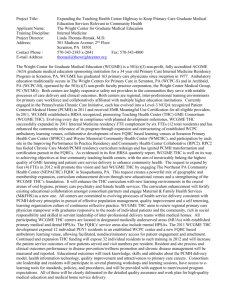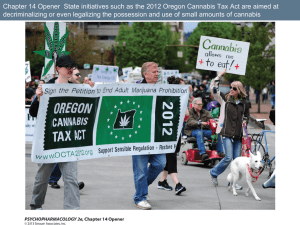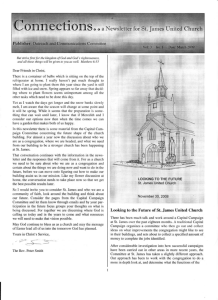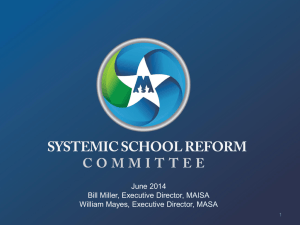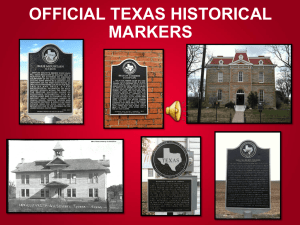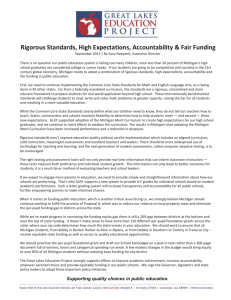Mens Rea August 2012 Measuring Nothing_AS
advertisement
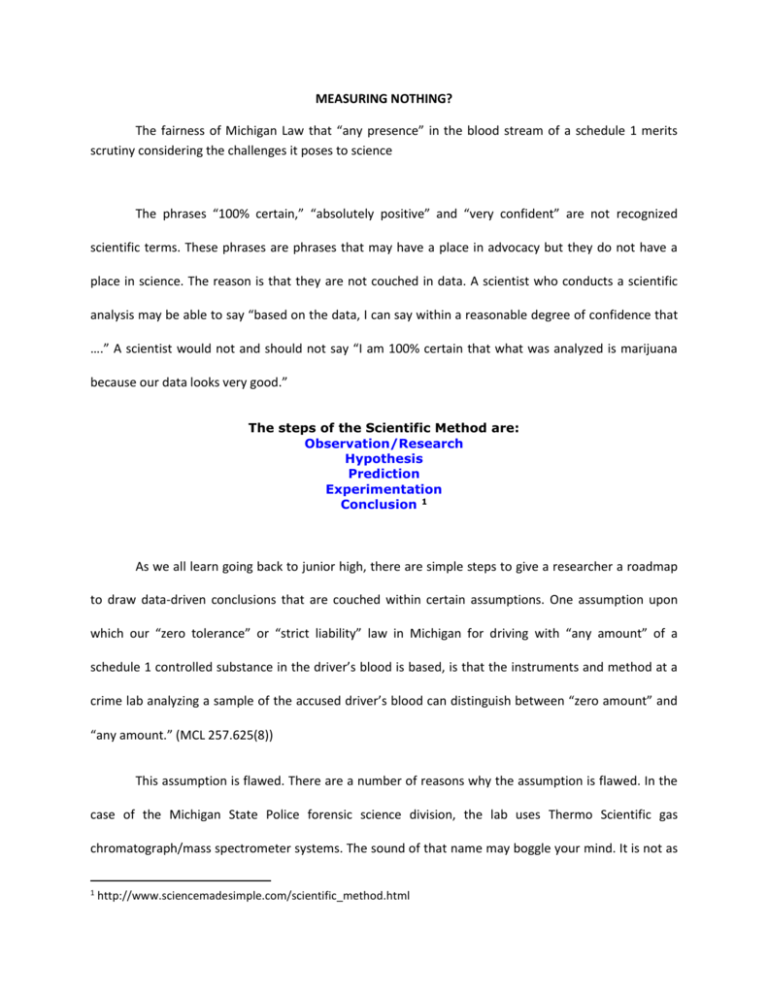
MEASURING NOTHING? The fairness of Michigan Law that “any presence” in the blood stream of a schedule 1 merits scrutiny considering the challenges it poses to science The phrases “100% certain,” “absolutely positive” and “very confident” are not recognized scientific terms. These phrases are phrases that may have a place in advocacy but they do not have a place in science. The reason is that they are not couched in data. A scientist who conducts a scientific analysis may be able to say “based on the data, I can say within a reasonable degree of confidence that ….” A scientist would not and should not say “I am 100% certain that what was analyzed is marijuana because our data looks very good.” The steps of the Scientific Method are: Observation/Research Hypothesis Prediction Experimentation Conclusion 1 As we all learn going back to junior high, there are simple steps to give a researcher a roadmap to draw data-driven conclusions that are couched within certain assumptions. One assumption upon which our “zero tolerance” or “strict liability” law in Michigan for driving with “any amount” of a schedule 1 controlled substance in the driver’s blood is based, is that the instruments and method at a crime lab analyzing a sample of the accused driver’s blood can distinguish between “zero amount” and “any amount.” (MCL 257.625(8)) This assumption is flawed. There are a number of reasons why the assumption is flawed. In the case of the Michigan State Police forensic science division, the lab uses Thermo Scientific gas chromatograph/mass spectrometer systems. The sound of that name may boggle your mind. It is not as 1 http://www.sciencemadesimple.com/scientific_method.html complicated as it seems on many levels. The gas chromatograph separates the compounds in a gaseous mix. The chromatograph is “taught” what time each compound separates from the mix when the analyst injects a mix with that compound into the chromatograph then observes the time it takes to separate. When a gas compound is injected with unknown compounds, the time that each component separates from the mix is analyzed. That is how the gas chromatograph identifies each component in the mix by separation. After the gas chromatograph separates the compound, the compound is injected into a mass spectrometer. The mass spectrometer breaks up the compound by electron beam bombardment and and identifies the characteristic mass pattern of the fragments. If the unique mass pattern is matched to the mass pattern for the compound of interest, then the analyst can identify the compound such as THC. Think of it like identifying points on a fingerprint. The Michigan State Police lab uses 12 “points” in its THC analysis 4 for THC, 4 for deuterated THC metabolite and 4 for the THC metabolite. Here is the big problem with the assumption that the instruments and method can measure nothing: there is always something there. One of the leading manufacturers of gas chromatographs/mass spectrometers is Agilent Technologies. A Technical Note published by the Chemical Analysis Group of Agilent recommends statistical methodology to determine the “noise detection limit” to determine the signal-to-noise ratio.2 The signal-to-noise ratio allows the analyst to understand the lowest quantity of a substance that can be distinguished from the system noise if the substance is absent from the sample (Wells, Prest and Russ, p 1). This limit is known as the “limit of detection.” There are a number of factors that contribute to the limit of detection. There are several types of limits that also need to be considered 2 Wells, Prest and Russ, “Signal, Noise, and Detection Limits in Mass Spectrometry,” Technical Note. Agilent Technologies. including the instrument detection limit, the method detection limit, the practical quantification limit and the limit of quantification. The Michigan State Police (MSP) administratively established its limit of detection at 0.1 ng/mL of THC and its limit of quantification at 1 ng/mL of THC. To give you some perspective, 1 nanogram per milliliter equates to a ½ teaspoon of sugar distributed throughout an Olympic sized pool.3 The limit of quantification is the so-called cutoff level or the level below which the MSP will not report that it detected THC in a blood sample. The MSP has never produced a study that demonstrates that this cut-off level is a valid one. In other words, no data or analysis shows why the cutoff level of 1 nanogram per milliliter is proper or even reasonable, considering the factors involved with method limits, instrument limits and other practical considerations. Former lab toxicologist Michelle Glinn analyzed some data on detection limits at the lab around 10 years ago before her departure from MSP.4 Her replacement, toxicology unit chief Geoff French, studied the data and says that he is unable to interpret the data fully but from what he can tell from the numbers that Dr. Glinn left behind, he does not agree with the methodology. In part, Mr. French says that Dr. Glinn used case results in the database which assumes that the case results reported were accurate.5 Mr. French also testified that the MSP is analyzing the current limit of quantitation or “cut-off” level and may increase it in the future.6 That news is certainly welcomed but it begs the question about the current language of MCL 257.625(8). The statute prohibits a person from operating a motor vehicle with “any amount” of a substance listed under schedule 1 of section 7212 of the Public Health Code. Those substances include marijuana. So, how does a person acquit himself of a charge under (8) of MCL 3 Andreas Stolz, PhD., testimony before the Honorable Thomas P. Boyd, May 24, 2012. Geoff French, B.S., testimony before the Honorable Thomas P. Boyd, May 24, 2012. 5 French, testimony before the Honorable Alfred E. Butzbaugh, July 13, 2012. 6 Ibid. 4 257.625 if all the state has to prove an amount of THC in the blood that equates to a ½ teaspoon of sugar in an Olympic size pool - especially if it is scientifically impossible to measure nothing? The courts are now confronting these issues. Hopefully, science will have a hand in the equation. Mike Nichols is a Sustaining Member of the National College for DUI Defense, the delegate for Michigan to the college; an associate member of the American Academy of Forensic Science (Jurisprudence section); the American Chemical Society; the National Association of Criminal Defense Lawyers; the Criminal Defense Attorneys of Michigan and the Ingham County Bar Association. He is author of the Michigan OWI Handbook by West and co-authored “DUI Mathematics” for the Inside the Minds Series by Aspatore Publishing. He is also an adjunct professor of DUI Law and Practice at Thomas M. Cooley Law School’s Lansing campus. mnichols@nicholslaw.net Special acknowledgment for this article goes to Andreas Stolz, Ph.D.

